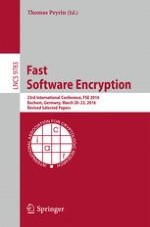2016 | OriginalPaper | Buchkapitel
Verifiable Side-Channel Security of Cryptographic Implementations: Constant-Time MEE-CBC
verfasst von : José Bacelar Almeida, Manuel Barbosa, Gilles Barthe, François Dupressoir
Erschienen in: Fast Software Encryption
Verlag: Springer Berlin Heidelberg
Aktivieren Sie unsere intelligente Suche, um passende Fachinhalte oder Patente zu finden.
Wählen Sie Textabschnitte aus um mit Künstlicher Intelligenz passenden Patente zu finden. powered by
Markieren Sie Textabschnitte, um KI-gestützt weitere passende Inhalte zu finden. powered by
